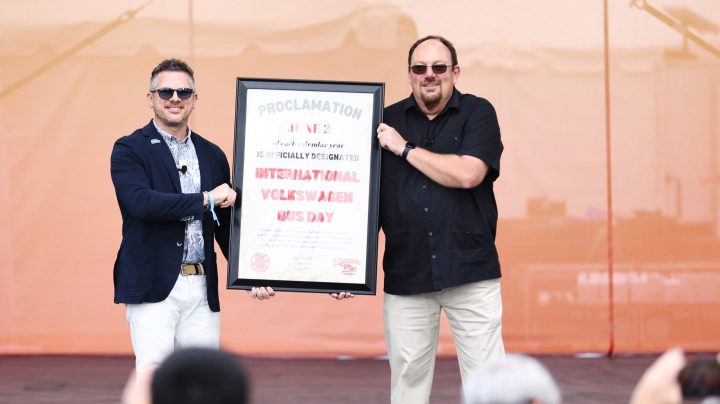
The big business of wacky holidays

If you’ve ever looked at a calendar and thought “Who invented that holiday?” It’s possible it came from Thomas and Ruth Roy of Lebanon, Pennsylvania.
“Ruth and I have created at least 80 wacky holidays,” said Thomas Roy. Those include Bathtub Party Day (December 5), National No Housework Day (April 7) and Sneak Some Zucchini onto Your Neighbors’ Porch Day (August 8).
You are not going to get a day off of work for Bathtub Party Day or any of the dozens of other holidays the Roys have created — they’re mostly just for fun.
Thomas Roy began his holiday-creating career in 1986 while flipping through Chase’s Calendar of Events, which publishes an annual guide to holidays, sporting events and celebrity birthdays. He noticed a form in the back you could fill out to submit new holidays. “I thought oh no, oh God help me … because I knew I was going to do it,” he said.
His first creation was Northern Hemisphere Hoodie-Hoo Day, on which revelers are instructed to celebrate the coming end of winter by going outside at high noon on February 20 and yelling “Hoodie-Hoo!”
Chase’s included Northern Hemisphere Hoodie-Hoo-Day in their next edition. When February 20 rolled around, newscasters picked up the story. “Of course, right away, I ran out to my desk and invented eight more holidays,” said Roy.
“It’s a little bit of a wild west out there with what people call holidays,” said Holly McGuire, Chase’s current editor-in-chief. She said it used to be more common for the federal government to proclaim special days, such as National Ice Cream Day, which was established by President Ronald Reagan in 1984. “Congress got bogged down with this, so they kind of stopped doing it,” she said. But, “people still wanted to celebrate the wacky stuff,” she said.
Though Thomas and Ruth Roy’s interest in inventing holidays is mostly recreational, they have made money from the hobby. They told Marketplace that a greeting card company paid them a few thousand dollars to print cards based on their holidays. They also said that brands, including Entenmann’s Bakery and Purina Pet Foods, have paid to use some of their holidays in marketing campaigns.
And the relationship between big business and niche holidays goes way back. California raisin growers began promoting National Raisin Day as early as 1909. A group of grocers started National Dairy Month in 1937 as a way to distribute extra milk during warm months.
Other days of celebration have unknown origins but provide useful marketing opportunities for companies.
Just ask Marlo Anderson, a North Dakota entrepreneur who started trying to track obscure holidays (and their history) in 2013. “It was just a personal blog for almost three years,” he said. “And it took over my life.”
Anderson’s office was soon inundated with calls and emails from people wanting to learn more about the holidays he’d written about or trying to create ones themselves. “We got kicked off of wordpress.com …because we had so much traffic coming to the website,” he said.
Today, Anderson’s company, National Day Calendar, has 12 full-time employees, a mobile app, a podcast, and a TV show in the works. It has become the unofficial arbiter of national days. Anderson said they get about 30,000 applications a year for new ones.
Companies sometimes pay thousands of dollars to have National Day Calendar proclaim and promote a special day.
Beth Warford, the founder of a self-defense training company, said she paid $5,000 to register September 26 as “National Situational Awareness Day” with National Day Calendar. “I think it was really worth it,” she said. “On the 26th, we get a lot more traffic to social media and our website — it’s our highest day.”
Some connections between National Days and the brands that sponsor them are obvious. Dole Packaged Foods, for example, sponsored National Dole Whip® Day. Others take a little more thought, like National Girls’ Night, which was submitted to National Day Calendar by Ketel One Botanical, a flavored vodka brand.
Other companies go to great lengths to become part of a news cycle for existing holidays.
The drive-through restaurant chain Checkers and Rally’s, for example, put together a marketing campaign specifically targeted at having National Day Calendar change National French Fry Day from July 13 to the second Friday in July so that it would always fall on Friday.
“I come to work one morning and there are like these wall drug signs up down Main Street that [said] ‘Hey, Marlo, don’t you know, Fry Day should be on Friday,'” said Anderson. “And it worked.”
Now why, might you ask, would a brand go to all of that effort for a made-up holiday?
“In consumer research, we don’t see people as rational processing agents,” said Nancy Gray, a professor of marketing at Arizona State University. “We are emotional, we are sometimes irrational, and we’re influenced by symbolic meaning.”
She said that celebrating a holiday, even a made-up one, creates an “extraordinary experience” for consumers by taking them out of their daily routine.
“Even if you’re skeptical of this, and you feel this tension, like ‘oh yeah, this is just for money, this is just a big attention grab’ … we don’t need to resolve [that] in our minds, to have a satisfying consumption experience with a brand,” she said.
There’s a lot happening in the world. Through it all, Marketplace is here for you.
You rely on Marketplace to break down the world’s events and tell you how it affects you in a fact-based, approachable way. We rely on your financial support to keep making that possible.
Your donation today powers the independent journalism that you rely on. For just $5/month, you can help sustain Marketplace so we can keep reporting on the things that matter to you.











